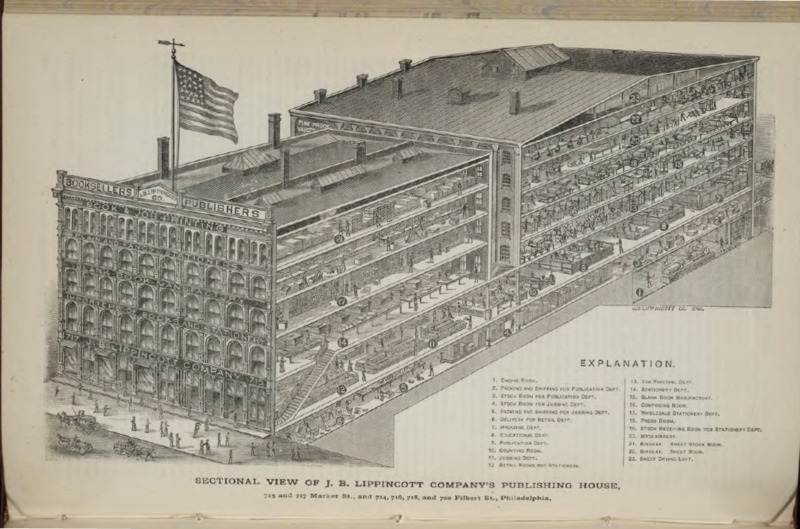J. B. Lippincott & Company
In the mid-nineteenth century, Lippincott was known for its sheer size and its ability to manufacture all aspects of the book. As a company, Lippincott dates its origins back to the late eighteenth century and the 1792 establishment of Jacob Johnson’s bookstore. Joshua Ballinger Lippincott himself was not born until 1813 in New Jersey and began working in the Philadelphia book trade for David Clark in his teens. When Clark’s business failed, Lippincott was put in charge, and the company ran as Clark and Lippincott in the 1830s before becoming J. B. Lippincott & Company, Booksellers and Stationers, in 1837 (Winship and Lyons). This company would then purchase Grigg, Elliot & Company in 1849 and reorganize temporarily as Lippincott, Grambo & Company, before again establishing itself as J. B. Lippincott & Company in 1855. In the early 1830s, the company occupied the corner of Fourth and Race Street in Philadelphia. But in 1861, the company moved to a large industrial facility at 715–717 Market Street, where it would remain until 1899, when a fire destroyed the building.
The Lippincott catalog was wide-ranging, with a specialization in reference books, medical texts, and bibles. In the Publishers’ Trade List Annual of 1874 the company’s books are listed in almost every category: arts and sciences, educational, guidebooks, history, biography, travel, Sunday school, medical, music, novels, theology and religion, stationery, and so on. Lippincott showed a particular interest in books on the western United States. It published Henry Rowe Schoolcraft’s six-volume series on the History, Condition, and Prospects of the Indian Tribes of the United States (1851–57) and H. M. Brackenridge’s Recollections of Persons and Places in the West (1868). In the wake of the Civil War, the company expanded rapidly and in 1868 began publishing Lippincott’s Monthly Magazine.
In 1871, Lippincott expanded on its 715–717 Market Street location, adding a large factory to the north. This Filbert Street factory was annexed to the Market Street building on its first two floors. The Lippincott offices and factory now covered more than five acres of land, and the company would remain here until 1899 when a fire destroyed the building. By purchasing paper, type, and ink, the factory could manage all aspects of book production—composing, stereotyping, printing, binding, and shipping. Indeed, Publishers Weekly printed a wonderful illustration of the building, with a cutaway view of its various departments, including the retail store, shipping rooms, the book bindery, and the magazine department.
Michael Winship and Matthew Lyons, Finding Aid for J. B. Lippincott Company Records, Collection 3104, Historical Society of Pennsylvania.
